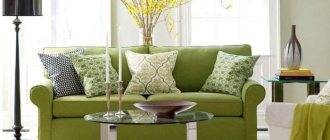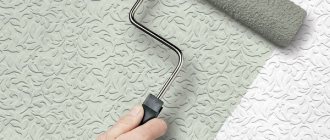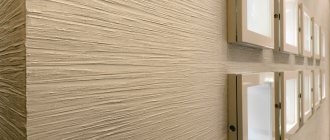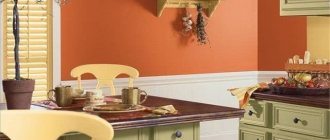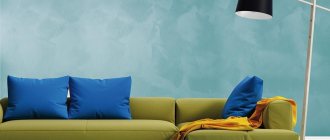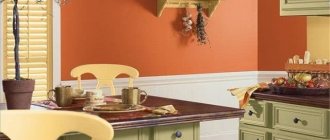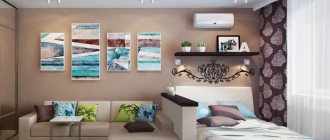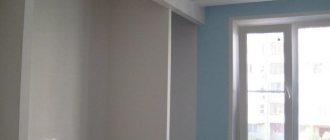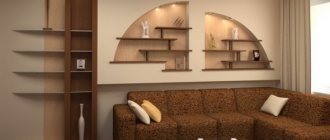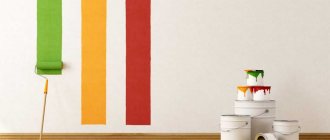Today it is difficult to say what is more often used for the finishing coating of premises: wallpaper or paint. Some people believe that using paints and varnishes you can only apply a single-color coating. Read our article and make sure that your walls are a canvas, and there are many devices around that can be used to embody unusual artistic solutions. Today we will tell you how and with what you can apply drawings to the walls.
Preparing the walls
First, you need to free access to the walls , for which the furniture is moved back a meter, and all exposed property is covered with a protective film, since acrylic dust will leave its mark when painting. If you have wallpaper to be painted, then check their joints and the presence of swellings, which are glued if necessary, but if the wall is painted using a putty mixture, then examine the surface for minor defects and eliminate them if found using starting putty followed by sanding.
Orange walls in the interior, what to combine orange with?
Save the article for yourself or share it on your favorite social networks:
The color orange attracts many people with its extraordinaryness, brightness, and cheerfulness. But, according to my observations, not all designers strive to use it as the main one when arranging interiors. This is explained traditionally. Orange is a difficult color to work with. Moreover, difficulties can arise at almost all stages. Still, I will take responsibility and tell you how the color orange can turn into your friend if used correctly. domisad.org
Orange walls are an advantage
The main advantage of orange is its immeasurable warmth. You can often read that the warmest color of the spectrum is red. It's actually orange. Well, I think you’ve already guessed where you can use the warmth of orange. Orange walls will be most relevant in those regions that undeservedly receive less summer sun and summer warmth. Even if you live in a warm region, but for some reason you personally do not have enough heat at home, orange will be your salvation. In addition to increasing the color temperature, orange will add warmth to the interior, which is important.
By the way, when using our color in interior design, it is necessary to take into account not only the region, but also the location of the rooms relative to the cardinal directions. If the windows in your room face northeast or north, orange walls will look perfect. If the windows face west or south, then I would not recommend painting the walls orange. Direct sunlight will cause the rich color to fade quickly. Even if the sun's rays are not direct, but oblique, orange under their influence will acquire a sultry, fiery burgundy hue.
Another positive thing that I recommend using when interacting with orange is the energetic fullness of the color. Indeed, orange walls will greatly change your interior. Being in such a room will not be tiring, but it will not be calm either. You won't be able to sit still. You will definitely want to do something active: stand up, walk, jump, vacuum, etc. This means that orange is not suitable for the bedroom. The same is the case with the living room. If you use it, including for personal relaxation in front of the TV, then under no circumstances paint the walls orange.
Orange wall color
I noticed that many people refuse orange because it is radical. But this misses one important point. You don't have to paint every wall in your room orange. For example, if you are relaxing in front of the TV, then the wall behind the TV may be white. But the wall behind you can be orange, and when guests come to you, it is enough to seat the company facing the orange wall so that the guests do not get bored. The combination of white and orange in the overall picture will look very decent. This is how one single orange wall can make the interior not only energetic, but also multifunctional.
Orange color combinations
In conclusion, I want to talk about the compatibility of orange. If you don’t want orange wallpaper to spoil the interior composition, combine it with brown, caramel, and dark chocolate. It will look warm and cozy and will look especially impressive in the living room and kitchen. Next, I recommend looking at options for combining orange with green shades, including olive and light green, but excluding herbal and coniferous. Green shades can be used for curtains or accessories. Finally, the orange color will look very fashionable in combination with purple, which will slightly compensate for the excessive saturation of our hero.
After we have figured out how to properly paint walls orange, it’s time to familiarize yourself with information about what colors orange goes with in more detail:
What is the best way to combine orange in an interior?
And specific colors:
Combination of orange and chocolate
Combination of orange and gray
Combination of orange and blue
Comments, answers to questions
- Nina The color Orange always creates a feeling of comfort and coziness in the home. And if you use it at work, in office premises, it will lift the spirits of all working employees and visiting clients. The use of orange on facades always attracts attention; in my city there is such a store - orange-yellow in color with the characteristic name "Orange" - you can immediately see, even by the color, that it sells fruit.
Answer
- Evgeniy A bright color of mood, you will never get tired of it, even if there is a lot of it. Think that traditional gray or brown walls will be quite dull and boring, while orange will make you look at things completely differently.
Answer
- Marina Good afternoon! Please tell me, I would like to change my room a little. I have orange walls and a wardrobe made of cherry wood, with steel inserts, frosted glass and mirrors. I'll leave the closet, it's built-in. I wanted to ask what colors all this can be combined with (color of the bed, curtains). And does it now match the walls, maybe the walls should be repainted too? Now the room is overloaded. And one more thing - a brown bed won’t fit into the interior? Thank you in advance
Answer
- admin Marina, as long as you have orange walls, it is better to stick to brown shades otherwise. It's a win-win. If you want to change something, then you can consider combinations such as orange with gray, turquoise, and dark blue (be careful here). If you change the color of the walls, then you need to decide what color to paint them and then select the rest. On my own behalf, I’ll add that although the brown-orange interior looks so warm and cozy, it can actually become boring later, so if you have the opportunity to choose a different color for the walls, it’s better to take advantage of it. But you still need to try to paint over such orange, make sure that they will repaint well (or apply plaster) and it will not show through under the lighter new paint (if that’s the paint you have there, as I understand from the photo).
Answer
Technology
A layer of primer is applied to the surface prepared for repainting , which creates an invisible film and is especially important in cases of strong changes in color. The primer mixture is applied in an even layer at a consumption of approximately 100 grams per m2 and smudges of the composition are immediately removed, since its base is glue and it will be difficult to remove it from the floor after setting.
The pigment is added to neutral-colored paint and mixed using a mixer, making sure that it is clean, otherwise the finished composition will have to be filtered. It is important to choose the right roller for repainting, since corrugated wallpaper requires a medium-pile tool, while a smooth surface can be treated with a foam roller or velor tool.
A telescopic rod for a roller will not be superfluous in the work, however, if you have not used it before, it will not speed up the process, but a bath for paint is necessary. First, use a brush to trim hard-to-reach areas, after which you can roll the entire wall, applying the first layer in any direction, and the second in the direction of the light. The interval between applying layers of acrylic paint should be at least 4 hours at a humidity of up to 60% and a temperature of 20 degrees. Remember that the paint dries darker , because when the water evaporates, the concentration of the dye increases, so do not make the color too dark, at least for the first layer.
You should always dilute acrylic paints with a reserve, since you may have to repaint the walls not in two, but in three layers (depending on the degree of color change) and remember the saying “the reserve does not last your pocket,” but you can find out about the approximate consumption of acrylic paint here.
If you are planning to repaint the walls in a different color yourself, then carefully prepare for the finishing and take your time in the process - this will guarantee a successful job, and we also suggest that you familiarize yourself with how to repaint the ceiling if your neighbors presented you with a “surprise”.
Questions and answers
Is it necessary to prime the walls?
A primer is considered mandatory if you dramatically change the contrast of the color of the walls, for example, blue to light green. In any case, priming will not hurt and will not take much time, so it is better to prime than not. A primer is also necessary if you want to remove greasy stains on wallpaper, but first you need to go over the stain with a detergent.
Does the direction of movement of the roller matter when repainting?
Creatively paint walls with special materials and tools
The easiest way to create an original interior is to use the assortment of the construction market. The variety of materials allows you to feel like a designer even without special education. We will talk about the most popular decoration technologies.
Texture paint and its effects
Textured coating is a thick mixture with the addition of acrylic or polymer components: sand, marble or granite particles, quartz dust or synthetic fibers. Interior decor using texture paint is a separate big topic. Within the framework of the article, we will only give a brief overview of the coatings that the finishing material creates.
Popular texture types
:
- Marseille wax
imitates the structure of natural stone. If you change the application technology, you will get a picture of a balsa wood cut.
- Mizuri
creates a deep relief surface.
- Relief
contains various additives, so the coating becomes rough and clearly structured.
- Atacama
contains metallized pigment particles. They have a reflective effect, so the coating is shiny and iridescent. It feels like running your hand over velvet fabric.
Before you decide to paint the walls with textured paint, calculate the required volume and cost. The coating consumption is high: on average, 1 l/1.5 sq.m., because for structuring the paint must be applied in a thick layer, and its cost is much higher than usual. With a limited budget and a large repair area, it is advisable to use another technology.
Why do you need textured rollers, spatulas and brushes?
The textured paint roller consists of a metal rod holder, a cylinder and a handle. The cylinder is made from a variety of materials: rubber, plastic, wood, leatherette, silicone or fabric. Due to such a variety of solutions, textured rollers make the surface non-uniform, create a pattern imitating textiles, stone, leather, bamboo, or help to apply a pattern no worse than that of expensive designer wallpaper. In the latter case, the design of the tool becomes more complicated. It has 2 rollers: one for creating an impression, the second for impregnation with paint.
Using the product you can texture not only paint, but also plaster. The depth and size of the relief will depend on the force you apply when working.
In recent years, the eco-theme in the interior has become popular, which is reflected in the range of painting materials. Using special spatulas, you can create the texture of wood rings. Do you want to imitate the pattern of natural wood flooring? Brush vertically down the newly painted surface with a wide, firm bristle brush. You will get a natural board pattern.
What are the advantages of using stencils
If you want to refresh or transform the interior, you can apply a clearly contoured pattern to the walls. A stencil is used for this. You can draw it yourself, cut a picture from the Internet and print it on large format paper, or buy a ready-made sample.
In addition to the fact that stencil designs add zest to the room, they have other advantages
:
- Variety of options.
Don't limit your imagination. Some depict nature, some depict abstract or geometric figures. You can create illustrations with inscriptions: declarations of love, compliments, motivating slogans.
- Economical.
You will update and diversify the style of the room at minimal cost.
- Masking of defects.
With the help of drawings, you can hide flaws or place visual accents so that flaws become invisible.
- Relaxing function.
Wall decor using stencils is a good way to have fun with your kids and show off your creativity.
To make sure you choose the right design, print it out and hang it on the wall with masking tape. Evaluate how harmonious it will look. Only then start working.
What you need for painting
The tool you will need is a ditch and a roller. You should carefully consider the choice of nozzle. For example, a smooth surface can be easily repainted with a short-pile roller, but for a textured surface with a deep texture it is better to use a long-pile roller.
Figure 4. A ditch and a roller are your main tools if you need to repaint wallpaper.
When using a foam roller, it is important to apply even pressure on it so as not to leave unpainted air bubbles, and you will have to constantly monitor the fur attachment so that hairs from it do not remain on the wall.
For corners and hard-to-reach places, it is better to stock up on a brush.
How to prepare walls for painting
When a wall is painted for the first time, its surface needs to be gradually prepared for this design. What exactly do they do:
- remove old finishes;
- prime the plane;
- cover up various flaws;
- putty, polish irregularities;
- prime again;
- wait until the putty is completely dry.
Upon completion of the preparatory work, the wall is completely ready for decorative painting.
Cramped rooms with an area of three to six square meters that do not have windows (such as a hallway, a bathroom) should not be painted in excessively cold, dark colors. It is also advisable to avoid large, bright designs - such a room will look very small.
Necessary materials, tools
To paint the walls of a room you will need approximately the following set of tools:
- rollers;
- sponges;
- tray;
- spatulas - steel, plastic, rubber, serrated;
- hard brushes;
- sandpaper;
- stencils – if you need to depict a clear pattern;
- a mixer or a special attachment for a drill - for stirring;
- masking tape - to protect areas that are not planned to be painted.
Before starting work, you should think about what kind of effect you plan to get, so as not to buy a bunch of unnecessary tools.
Features of painting yellow wallpaper from different materials
Depending on what material the base surface is made of, there may be nuances:
- non-woven fabric has a textured surface, so in order to completely hide light yellowish shades, it is better to walk over it twice. However, you should not allow the wallpaper to become completely saturated and run the roller over the same place for a long time;
- Paintable yellow vinyl wallpaper requires a preliminary primer, and then the application of two layers of paint. It is not necessary to completely dry the first layer, but it is advisable to use a nozzle with long pile for a high-quality color change;
- paper (even in a modern, thick version) does not like an excess of paint, so one layer of a new color is enough for it;
- fiberglass is the most resistant to repainting, but necessarily requires preliminary priming. It is covered with at least two layers of latex, wax or acrylic paint.
Important: to ensure the effectiveness of the result, first try painting some place hidden from view (behind a cabinet, near the baseboard, etc.). If you are satisfied with everything, start artistic experiments!
Source
We use improvised means to decorate walls with paint
Designers have come up with various ways to decorate walls using materials that can be found in every home or in any hardware store. We will describe the simplest and most accessible methods of drawing.
Pre-test your chosen technology. Take a small sheet of drywall and paint it the way you want. Evaluate the result in all parts of the room and at different times of the day. This way you will find out whether the drawing will look beautiful, and whether the decor method is suitable for a room of your size and lighting.
How to apply a design to a wall using paint
with your own hands:
- Wrap a regular paint roller with bubble wrap. You'll get a cute polka dot cover.
- Brush over the fresh paint with a hand brush. Move in any direction, depending on the geometry you want. Don't try to make the stripes perfectly straight; a little carelessness will make the texture natural.
- Wrap the roller in cotton cloth, securing it at both ends with rubber bands. The more folds there are on the canvas, the better. Apply the base paint, then randomly apply the second color using a homemade tool. If you don't have a roller, roll up a piece of fabric and roll it along the wall. It will take longer, but the effect will be about the same.
Instead of regular fabric, you can use a knitted product with a pattern. The print will repeat the pattern on the clothing.
- Use sponges of different porosity, shape and density. Using rectangular specimens, you can create an imitation of brickwork, and soft models for washing dishes will help you apply a blurred, heterogeneous pattern.
- You can also use a sponge to create a watercolor painting. Paint the surface with a white base. Wet the sponge in colored paint and completely immerse it in water, immediately pulling it out and squeezing it out. Blot the wall. If the shade lies tightly, stretch it to the sides using circular movements. The more water, the lighter and more weightless the image will appear.
- Trim the roller. Using tape, chaotically glue individual parts of any shape onto the roller. Remove the lint between them with scissors or a clipper. Remove the tape.
Is it possible to repaint already painted walls and what is needed for this?
The apartment was renovated five years ago. The walls were painted in bright colors, now I’m going to slightly update the interior design of the apartment. I’m tired of bright colors, so as not to spend a lot on repairs, I just want to repaint the walls in softer colors - beige, light yellow.
There are no obvious defects on the wall, but I’m afraid that the existing purple color of the walls in the nursery will show through the applied beige paint. Is any preparation of the walls necessary before repainting them in lighter colors?
Multi-colored stripe
Perhaps one of the simplest methods for creating an unusual wall pattern is to apply bright stripes with paints in contrasting shades. This can be done using a roller (if the stripes are wide) or a brush (if they are narrow), masking tape and a high-quality color coating.
To do this, you must first paint the wall with a base shade, then stick masking tape in place of the stripes and carefully fill all the resulting voids with paint of a different tone. When it is completely dry, carefully remove the tape. If you did everything correctly, you should have perfectly even, beautiful stripes.
By the way, they do not have to be made horizontal or vertical. If desired, they can be placed even at an angle - the main thing is that they fit into the surrounding environment of the house. The same applies to the selection of colors. The simplest solution is to make the stripes two-tone, but if it seems boring to you, you can always paint them in all the colors of the rainbow or combine 3-4-5, or even more, any shades of paint.
Recommended Posts
Recently viewed by 0 users
No registered user is viewing this page.
Chandeliers for the kitchen in a modern style: 100+ photos of the best models and tips for choosing
Kitchen design: 12 design options in different styles
Gzhel motifs
The best articles on the IVD website
Are you a professional architect or designer?
IVD. Repair and finishing
Are you a professional architect or designer?
Smooth ombre
Painting walls with a smooth color transition from a darker to a lighter shade is an excellent solution for those who have decided to slightly refresh the design of their own home. You can get the ombre effect in several ways:
- cover the wall with the lightest tone from the selected color scheme, and then, moving from bottom to top, apply several layers of darker paint, making sure that each subsequent one ends slightly lower than the previous one;
- or a similar effect can be created by different geometric patterns and lines, painted in darker and lighter tones, distributed according to exactly the same principle that we described above.
Creating a texture using tools
An easy way is to spray the paint with a brush or brush. After the wall is evenly painted in a certain shade and is completely dry, take a brush or broom, dip the tool into a coating of a different color and splash the paint onto the walls. If you take several shades, the effect will be more interesting. But at first the splashes may be too uneven. Therefore, it is better to practice somewhere.
Creating an invoice yourself
You can “improve” the roller. To do this, we tie strips of fabric to it or glue pieces of dense material so that the roller leaves an unusual pattern on the wall. In specialty stores you can purchase special rollers to create texture. They have two pads: paint is applied to one, and the second has a relief pattern that is interrupted onto the surface.
After looking at photo design ideas for painting walls with water-based paint, you can come up with your own unique method. For example, on the farm there are interesting devices that can be used to leave interesting contours and patterns and create reliefs. Don’t be afraid to experiment, but don’t forget to practice before finishing to ensure a high-quality result.
